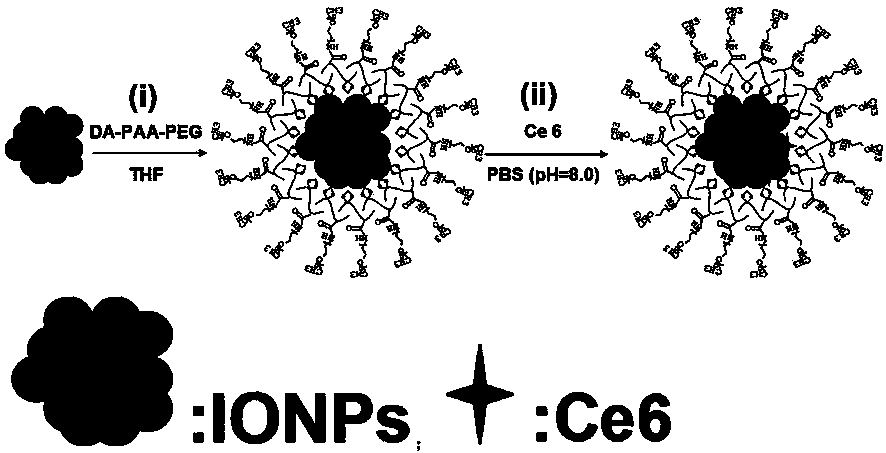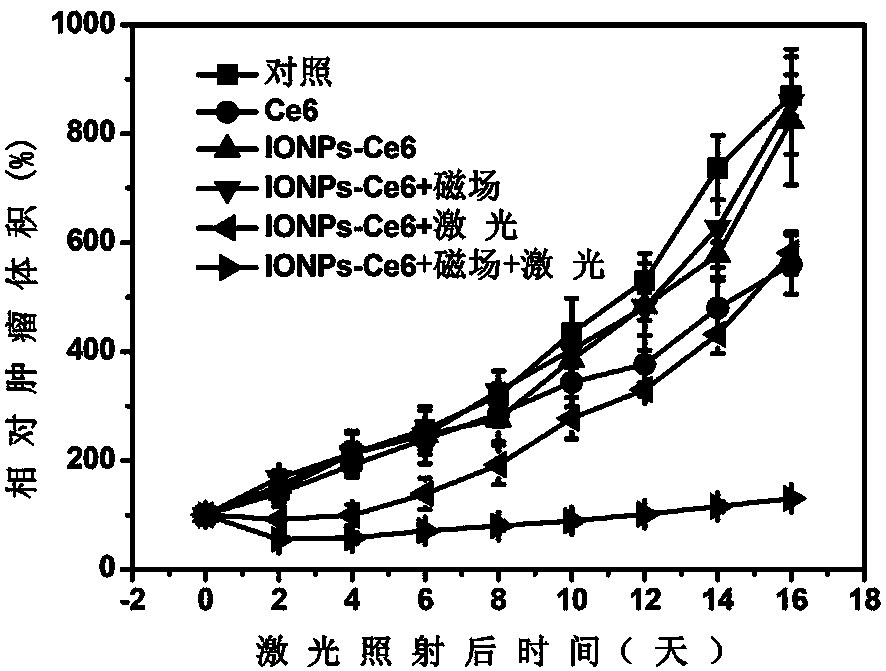Polyethylene glycol modified magnetic nanoparticle and application thereof
A technology of magnetic nanoparticles and polyethylene glycol, applied in the field of medicine, can solve problems such as damage to normal tissue cells, sequelae and tissue dysfunction, and achieve the goals of inhibiting tumor growth, excellent biocompatibility, and high photodynamic therapy efficiency Effect
- Summary
- Abstract
- Description
- Claims
- Application Information
AI Technical Summary
Problems solved by technology
Method used
Image
Examples
Embodiment 1
[0043] Example 1: Preparation of polyethylene glycol-modified magnetic Fe 3 o 4 nanoparticles
[0044] Preparation of DA-PAA-PEG-modified Fe by Chelation 3 o 4 Magnetic nanoparticles, specifically comprising the following steps:
[0045] (1) Preparation of Fe3O4 magnetic nanoparticles: 0.541g FeCl 3 ·6H 2 O was dissolved in a mixed solvent of 6 mL of ethylene glycol and 14 mL of diethylene glycol. Seal and stir for 30 minutes, then add 2g of polyvinylpyrrolidone (PVP); 120°C oil bath, stir for 1h; then add 1.5g of anhydrous sodium acetate, stop heating and continue stirring for 30min; transfer to two 20mL high temperature Teflon-lined In a high-pressure reaction kettle, each reaction kettle is 10mL, and heated in an oven at 200°C for 12h; the prepared Fe3O4 magnetic nanoparticles are washed with ethanol three times, referred to as IONPs;
[0046] (2) Preparation of DA-PAA-PEG graft copolymer: take 18mg PAA (MW=1.8KD), 625mg PEG-NH 2 (MW=5KD) was dissolved in 2mL N,N-di...
Embodiment 2
[0049] Example 2: Preparation of polyethylene glycol-modified magnetic nanoparticles
[0050] Fc modified in DA-PAA-PEG by chelation 3 o 4 The photosensitive molecule Ce6 is loaded on the magnetic nanoparticles, which specifically includes the following steps:
[0051] Take 100 μL of 2 mg / mL DA-PAA-PEG-modified Fe 3 o 4 Magnetic nanoparticles were added to a 2 mL centrifuge tube. Weigh 10 mg of Ce6 and dissolve it in 1 mL of dimethyl sulfoxide (DMSO). Add 10, 20, 50, 100, 150, and 200 μL of Ce6 solution to the above-mentioned 2 mL centrifuge tube to obtain 6 sets of solutions; then add 0.02M PBS buffer solution with pH=8.0 to adjust the solution to be alkaline. Shake with a shaker for 12 hours at room temperature and protected from light. After the end, wash with 0.02M PBS buffer solution with pH=8.0 until the supernatant is colorless, and obtain polyethylene glycol-modified magnetic nanoparticles, referred to as IONPs-PEG-Ce6, and its structure diagram is shown in the a...
Embodiment 3
[0053] Example 3: Determination of Singlet Oxygen Production
[0054] Add 50 μL of 0.2 mg / mL IONPs-PEG, IONPs-PEG-Ce6, 10 uL of 0.1 mM Ce6 and 5 μL of 1 mM singlet oxygen measurement fluorescent molecule SOSG (Singlet Oxygen Sensor Green) into the cuvette, add water to volume 2mL. SOSG is a fluorescent probe commercially used to detect singlet oxygen. Its excitation wavelength is 494nm and its emission peak is at 530nm. The final concentration of Ce6 is 0.5uM; the concentration of ferric oxide nanoparticles is 5μg / mL; the concentration of SOSG is 2.5μM. At 704nm, 5mW / mm 2 Under laser irradiation, the singlet oxygen probe SOSG fluorescence intensity changes at different time points were observed to characterize the ability of the material to generate singlet oxygen.
[0055] attached Image 6 It is a diagram of the fluorescence intensity change of the above materials at different time points after laser irradiation, from which it can be seen that the fluorescence intensity ...
PUM
| Property | Measurement | Unit |
|---|---|---|
| The average particle size | aaaaa | aaaaa |
Abstract
Description
Claims
Application Information
 Login to View More
Login to View More - R&D
- Intellectual Property
- Life Sciences
- Materials
- Tech Scout
- Unparalleled Data Quality
- Higher Quality Content
- 60% Fewer Hallucinations
Browse by: Latest US Patents, China's latest patents, Technical Efficacy Thesaurus, Application Domain, Technology Topic, Popular Technical Reports.
© 2025 PatSnap. All rights reserved.Legal|Privacy policy|Modern Slavery Act Transparency Statement|Sitemap|About US| Contact US: help@patsnap.com



